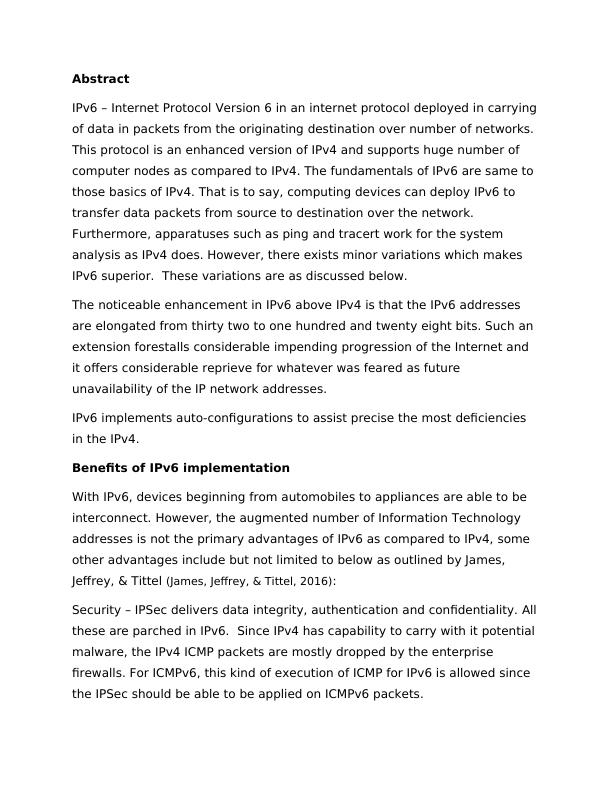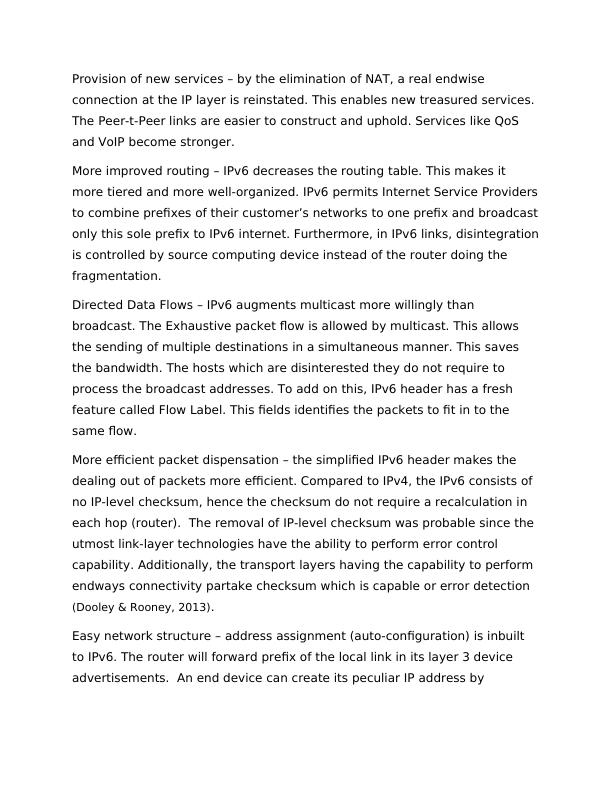IPv6 - Internet Protocol Version 6
Added on 2022-11-18
6 Pages1327 Words112 Views
Assignment title and code:
Student name:
Assessor name:
Student Affiliation:
Submission date:
Student name:
Assessor name:
Student Affiliation:
Submission date:

Abstract
IPv6 – Internet Protocol Version 6 in an internet protocol deployed in carrying
of data in packets from the originating destination over number of networks.
This protocol is an enhanced version of IPv4 and supports huge number of
computer nodes as compared to IPv4. The fundamentals of IPv6 are same to
those basics of IPv4. That is to say, computing devices can deploy IPv6 to
transfer data packets from source to destination over the network.
Furthermore, apparatuses such as ping and tracert work for the system
analysis as IPv4 does. However, there exists minor variations which makes
IPv6 superior. These variations are as discussed below.
The noticeable enhancement in IPv6 above IPv4 is that the IPv6 addresses
are elongated from thirty two to one hundred and twenty eight bits. Such an
extension forestalls considerable impending progression of the Internet and
it offers considerable reprieve for whatever was feared as future
unavailability of the IP network addresses.
IPv6 implements auto-configurations to assist precise the most deficiencies
in the IPv4.
Benefits of IPv6 implementation
With IPv6, devices beginning from automobiles to appliances are able to be
interconnect. However, the augmented number of Information Technology
addresses is not the primary advantages of IPv6 as compared to IPv4, some
other advantages include but not limited to below as outlined by James,
Jeffrey, & Tittel (James, Jeffrey, & Tittel, 2016):
Security – IPSec delivers data integrity, authentication and confidentiality. All
these are parched in IPv6. Since IPv4 has capability to carry with it potential
malware, the IPv4 ICMP packets are mostly dropped by the enterprise
firewalls. For ICMPv6, this kind of execution of ICMP for IPv6 is allowed since
the IPSec should be able to be applied on ICMPv6 packets.
IPv6 – Internet Protocol Version 6 in an internet protocol deployed in carrying
of data in packets from the originating destination over number of networks.
This protocol is an enhanced version of IPv4 and supports huge number of
computer nodes as compared to IPv4. The fundamentals of IPv6 are same to
those basics of IPv4. That is to say, computing devices can deploy IPv6 to
transfer data packets from source to destination over the network.
Furthermore, apparatuses such as ping and tracert work for the system
analysis as IPv4 does. However, there exists minor variations which makes
IPv6 superior. These variations are as discussed below.
The noticeable enhancement in IPv6 above IPv4 is that the IPv6 addresses
are elongated from thirty two to one hundred and twenty eight bits. Such an
extension forestalls considerable impending progression of the Internet and
it offers considerable reprieve for whatever was feared as future
unavailability of the IP network addresses.
IPv6 implements auto-configurations to assist precise the most deficiencies
in the IPv4.
Benefits of IPv6 implementation
With IPv6, devices beginning from automobiles to appliances are able to be
interconnect. However, the augmented number of Information Technology
addresses is not the primary advantages of IPv6 as compared to IPv4, some
other advantages include but not limited to below as outlined by James,
Jeffrey, & Tittel (James, Jeffrey, & Tittel, 2016):
Security – IPSec delivers data integrity, authentication and confidentiality. All
these are parched in IPv6. Since IPv4 has capability to carry with it potential
malware, the IPv4 ICMP packets are mostly dropped by the enterprise
firewalls. For ICMPv6, this kind of execution of ICMP for IPv6 is allowed since
the IPSec should be able to be applied on ICMPv6 packets.

Provision of new services – by the elimination of NAT, a real endwise
connection at the IP layer is reinstated. This enables new treasured services.
The Peer-t-Peer links are easier to construct and uphold. Services like QoS
and VoIP become stronger.
More improved routing – IPv6 decreases the routing table. This makes it
more tiered and more well-organized. IPv6 permits Internet Service Providers
to combine prefixes of their customer’s networks to one prefix and broadcast
only this sole prefix to IPv6 internet. Furthermore, in IPv6 links, disintegration
is controlled by source computing device instead of the router doing the
fragmentation.
Directed Data Flows – IPv6 augments multicast more willingly than
broadcast. The Exhaustive packet flow is allowed by multicast. This allows
the sending of multiple destinations in a simultaneous manner. This saves
the bandwidth. The hosts which are disinterested they do not require to
process the broadcast addresses. To add on this, IPv6 header has a fresh
feature called Flow Label. This fields identifies the packets to fit in to the
same flow.
More efficient packet dispensation – the simplified IPv6 header makes the
dealing out of packets more efficient. Compared to IPv4, the IPv6 consists of
no IP-level checksum, hence the checksum do not require a recalculation in
each hop (router). The removal of IP-level checksum was probable since the
utmost link-layer technologies have the ability to perform error control
capability. Additionally, the transport layers having the capability to perform
endways connectivity partake checksum which is capable or error detection
(Dooley & Rooney, 2013).
Easy network structure – address assignment (auto-configuration) is inbuilt
to IPv6. The router will forward prefix of the local link in its layer 3 device
advertisements. An end device can create its peculiar IP address by
connection at the IP layer is reinstated. This enables new treasured services.
The Peer-t-Peer links are easier to construct and uphold. Services like QoS
and VoIP become stronger.
More improved routing – IPv6 decreases the routing table. This makes it
more tiered and more well-organized. IPv6 permits Internet Service Providers
to combine prefixes of their customer’s networks to one prefix and broadcast
only this sole prefix to IPv6 internet. Furthermore, in IPv6 links, disintegration
is controlled by source computing device instead of the router doing the
fragmentation.
Directed Data Flows – IPv6 augments multicast more willingly than
broadcast. The Exhaustive packet flow is allowed by multicast. This allows
the sending of multiple destinations in a simultaneous manner. This saves
the bandwidth. The hosts which are disinterested they do not require to
process the broadcast addresses. To add on this, IPv6 header has a fresh
feature called Flow Label. This fields identifies the packets to fit in to the
same flow.
More efficient packet dispensation – the simplified IPv6 header makes the
dealing out of packets more efficient. Compared to IPv4, the IPv6 consists of
no IP-level checksum, hence the checksum do not require a recalculation in
each hop (router). The removal of IP-level checksum was probable since the
utmost link-layer technologies have the ability to perform error control
capability. Additionally, the transport layers having the capability to perform
endways connectivity partake checksum which is capable or error detection
(Dooley & Rooney, 2013).
Easy network structure – address assignment (auto-configuration) is inbuilt
to IPv6. The router will forward prefix of the local link in its layer 3 device
advertisements. An end device can create its peculiar IP address by

End of preview
Want to access all the pages? Upload your documents or become a member.
Related Documents
Intermediate Computer Networking: Part Blg...
|9
|2022
|441
Computer Networks: Routing Protocols, ICMP Packet Encapsulation, and Convergence Propertieslg...
|12
|2290
|406
Web and Data Security: Guide to Network Defense and Countermeasureslg...
|2
|607
|224
CSC81001: Computer Networks Assignment 2022lg...
|13
|1941
|20
Assignment On Fundamentals Of Computer Systemlg...
|11
|2375
|26
Fundamental of Computer Systemlg...
|11
|2560
|288
